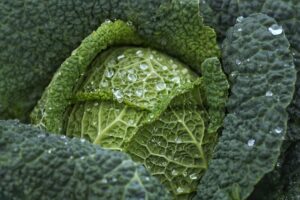In this document, we will discuss cabbage growing stages. Cabbage is a cool-season crop that is relatively easy to grow and requires minimal maintenance. Understanding the different stages of cabbage growth can help you plan and manage your garden better. Let’s dive in!
Cabbage Seed Selection
Choose high-quality cabbage seeds suitable for your climate. Look for seeds that have a high germination rate and are disease-resistant. You can also buy seedlings from a local nursery if you prefer not to start from seeds.
Starting Cabbage Seeds Indoors
You can plant cabbage seeds indoors about 6 to 8 weeks before the last expected frost date in your area. Starting seeds indoors helps protect the young plants from harsh weather and gives them a head start when transplanting them into the garden once the outdoor temperatures are consistently above 45 degrees Fahrenheit. Use a seed starting mix and keep the soil moist to ensure proper germination and growth.
Planting Cabbage Seeds Outdoors
Cabbage seeds can be planted outdoors when the soil can be worked in early spring, as cabbages tolerate frost and can be grown in cool temperatures. Pay attention to soil readiness; if the earth is thawed and no longer sodden from winter precipitation, it can be deemed workable. Ideally, soil temperatures should be at least 40 degrees Fahrenheit. Aim to plant the seeds about 2 to 4 weeks before the last spring frost date for optimal growth.
Pre-Soaking Seeds
Soaking cabbage seeds before planting is not necessary, but it can speed up germination. If you choose to soak seeds, do it for around 12 to 24 hours in warm water. This pre-soaking can help break dormancy and activate the germination process. However, ensure the seeds do not remain in water for too long as this could cause them to rot. After soaking, plant them immediately in well-draining soil.
Seed Sowing Techniques
When planting cabbage seeds, it’s important to use the proper technique to ensure successful growth. Plant seeds in a well-prepared seedbed or potting mix that is loose, fertile, and well-draining. The ideal depth for sowing cabbage seeds is about 1/4 inch into the soil. Space the seeds about 2 to 3 inches apart in rows, allowing 24 to 36 inches between each row for adequate airflow and growth.
When considering how many seeds to plant per hole, it’s prudent to place 2 to 3 seeds in each spot. If more than one germinates, you can thin out the seedlings later, leaving the strongest plant to grow. This method helps increase the likelihood of cultivation in case some of the seeds do not germinate. Remember to keep the soil consistently moist during germination, which typically takes 5 to 17 days.
Seasonal Considerations for Planting Cabbage
Cabbage is a remarkably versatile crop in terms of planting seasons, but it generally thrives when planted in early spring or late summer. Spring plantings take advantage of the cool temperatures that cabbages favor for their growth and help avoid the peak pest season. For a fall harvest, planting in late summer will ensure the plants mature as the weather cools down, often leading to a sweeter taste in the leaves. It is less advisable to plant cabbages in the peak of summer due to the high heat, which can hinder development and lead to a bitter flavor.
Understanding Germination in Cabbage Seeds
Germination is the vital process through which a cabbage seed emerges from dormancy and develops into a young seedling, marking the onset of growth. For cabbage seeds, the germination process typically occurs within 5 to 17 days under optimal conditions. This period can vary depending on factors such as soil temperature, moisture levels, and the quality of the seeds. During germination, it’s crucial to maintain a consistent soil moisture and ensure the temperature stays within the ideal range of 45–85°F (7–29°C), with warmer temperatures generally encouraging faster germination rates.
Nurturing Cabbage Seedlings
Once the cabbage seeds have germinated, the seedling stage commences as the first leaves, known as cotyledons, become visible. These embryonic leaves are a critical indicator of successful germination and provide the initial nutrients the seedlings require to grow. It’s essential during this phase to continue monitoring soil moisture and to begin introducing a balanced fertilizer to encourage strong growth. As the true leaves develop, which are the leaves that grow after the cotyledons, seedlings can gradually be introduced to more direct sunlight to harden off, preparing them for eventual transplanting to the garden.
Transplanting Cabbage Seedlings
Transplanting is a critical stage in cabbage cultivation, where the robust seedlings are moved to their final growing location. The best time to transplant in spring is when the seedlings are around 4-6 weeks old and after the last frost has passed to prevent cold damage. In summer, aim for an evening transplant to avoid the midday heat which can stress the plants. Cabbage seedlings should be planted 12–24 inches apart in rows, allowing sufficient space for growth and airflow. This spacing helps to reduce the risk of disease and provides ample room for the cabbages to develop their characteristic heads.
The Vegetative Stage of Cabbage Growth
During the vegetative stage, a cabbage plant begins to expand in size and produce larger, more numerous leaves before forming its head. This growth phase is vital for accumulating the necessary energy and biomass to support the development and maturation of the cabbage head itself. To support this rapid growth, cabbage requires consistent fertilization and watering. It’s recommended to fertilize cabbage every 2 to 4 weeks with a nitrogen-rich fertilizer to encourage leafy growth. When it comes to watering, cabbage benefits from regular moisture and should be watered thoroughly 1 to 1.5 inches per week, depending on rainfall and soil conditions. However, overwatering must be avoided as it can lead to root rot and other diseases. Soil moisture can be checked by feel: the soil should be moist but not waterlogged.
Heading Stage: Formation of the Cabbage Head
As the cabbage plant progresses through the vegetative stage, a notable shift occurs when the inner leaves begin to fold inward, marking the onset of the heading stage. This is the critical phase when the cabbage starts to form the dense and leafy head that it is known for. To ensure a well-formed head, it is essential to continue your diligent care regimen, particularly focusing on watering and fertilizing. The soil should be kept consistently moist but not soggy; aim for deep watering sessions rather than frequent light sprinkles to encourage strong root development. Fertilizing should be carried out with a balanced, lower nitrogen formula as excessive nitrogen at this stage can lead to leafy growth at the expense of the head. Monitoring the growth during this time is key to addressing any nutritional deficiencies or water needs, ensuring the head forms tightly and reaches its full size potential.
Heading Stage: Maturation and Harvest
Once the cabbage head is well-formed, the plant enters the maturation stage. It is during this stage that the head becomes firm to the touch—a clear sign of readiness for harvest. Generally, from planting the seeds to harvesting, cabbage takes about 70 to 85 days depending on the variety and growing conditions. When the head feels firm, it should be cut from the base of the plant with a sharp knife, taking care not to crush or damage the head. Harvesting at the right time is crucial; if left too long, the cabbage can split as a result of overgrowth or excessive moisture, which makes it susceptible to pests and diseases. A properly timed harvest ensures a crisp texture and the best flavor profile for your cabbage.
Cabbage Post-Harvest Tips and Regrowth
After you’ve harvested your cabbage by cutting the mature head from the plant, it’s important to leave a few protective outer leaves intact. These leaves can help to shield the remaining part of the plant from direct sunlight, reducing the likelihood of wilting and providing a layer of protection during storage.
While cabbages are generally biennial, some varieties have the ability to produce smaller secondary heads, a process known as “ratooning.” Once the main head is harvested, leave the plant in place and maintain regular watering. Smaller shoots may develop from the stalk. These secondary heads will not be as large as the primary one, but they can provide an additional, albeit smaller, yield. This method allows gardeners to make the most out of each plant, extending the harvest season.


